中国书法英文介绍[优质ppt]
- 格式:ppt
- 大小:2.07 MB
- 文档页数:15
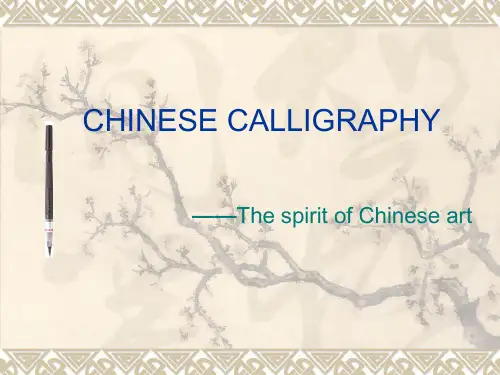
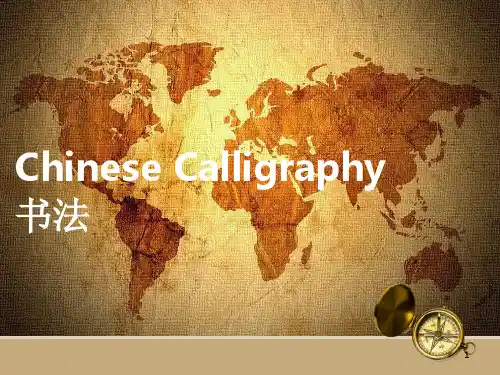
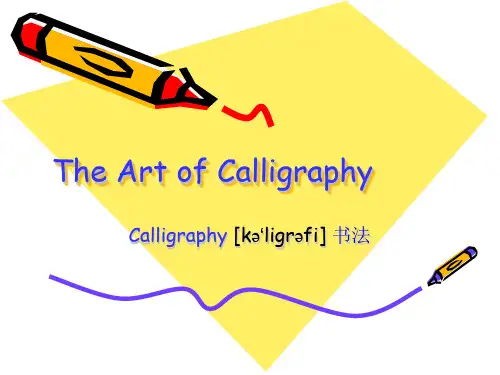
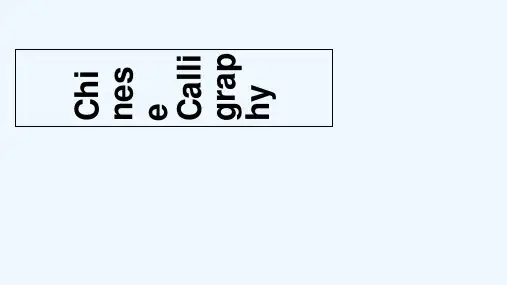
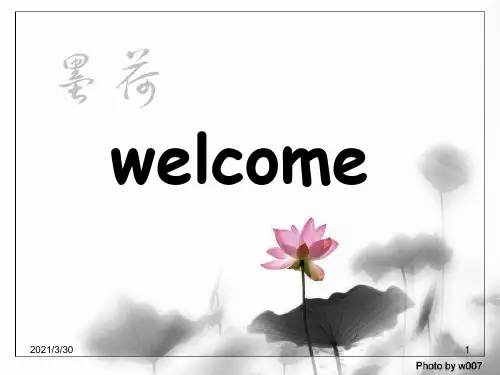

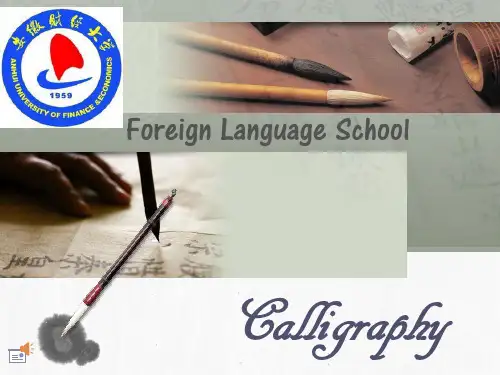

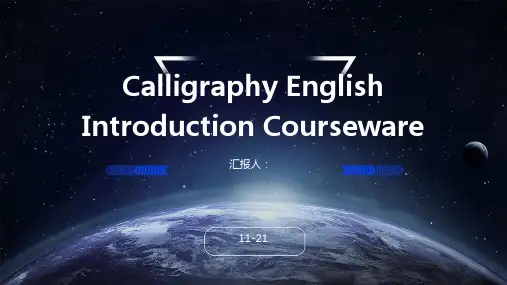
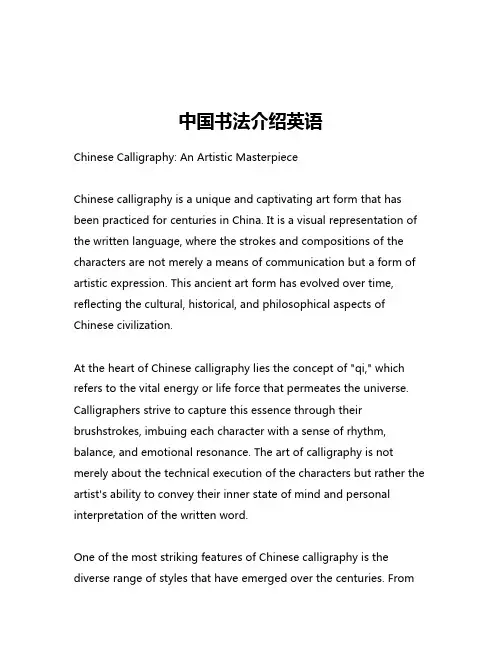
中国书法介绍英语Chinese Calligraphy: An Artistic MasterpieceChinese calligraphy is a unique and captivating art form that has been practiced for centuries in China. It is a visual representation of the written language, where the strokes and compositions of the characters are not merely a means of communication but a form of artistic expression. This ancient art form has evolved over time, reflecting the cultural, historical, and philosophical aspects of Chinese civilization.At the heart of Chinese calligraphy lies the concept of "qi," which refers to the vital energy or life force that permeates the universe. Calligraphers strive to capture this essence through their brushstrokes, imbuing each character with a sense of rhythm, balance, and emotional resonance. The art of calligraphy is not merely about the technical execution of the characters but rather the artist's ability to convey their inner state of mind and personal interpretation of the written word.One of the most striking features of Chinese calligraphy is the diverse range of styles that have emerged over the centuries. Fromthe bold and commanding "Kaishu" (regular script) to the fluid and expressive "Xingshu" (cursive script), each style reflects the unique aesthetic sensibilities and personal preferences of the calligrapher. The choice of script, the thickness and rhythm of the strokes, and the overall composition of the characters all contribute to the distinct character of a calligraphic work.The materials used in Chinese calligraphy are equally significant. The traditional tools include the brush, ink, paper, and inkstone, each of which plays a crucial role in the creative process. The brush, in particular, is an extension of the calligrapher's hand, allowing them to effortlessly manipulate the ink and create a wide range of expressive strokes. The quality of the paper, with its subtle textures and absorbent properties, also influences the final outcome, as it interacts with the ink to produce unique visual effects.The practice of Chinese calligraphy is not merely a technical exercise but a deeply introspective and spiritual process. Calligraphers often engage in meditative practices to cultivate a calm and focused state of mind, which is then reflected in the fluidity and harmony of their brushstrokes. The act of creating a calligraphic work is seen as a journey of self-discovery, where the artist's personal experiences, emotions, and philosophical beliefs are woven into the fabric of the artwork.Beyond its aesthetic appeal, Chinese calligraphy also serves as a window into the rich cultural heritage of China. The evolution of calligraphic styles is closely tied to the development of Chinese literature, history, and social customs. Each dynasty and region has its own distinctive calligraphic traditions, reflecting the unique cultural influences and artistic preferences of the time.In recent years, Chinese calligraphy has gained increasing global recognition, with artists and enthusiasts around the world exploring and appreciating this captivating art form. Contemporary calligraphers have also embraced new mediums and techniques, blending traditional practices with modern sensibilities to create innovative and thought-provoking works.In conclusion, Chinese calligraphy is a profound and multifaceted art form that continues to captivate and inspire audiences worldwide. From its deep-rooted cultural significance to its mesmerizing visual aesthetics, this ancient art form is a testament to the enduring creativity and spiritual essence of the Chinese people. Whether one is a seasoned connoisseur or a curious newcomer, the world of Chinese calligraphy offers a rich and rewarding journey of discovery and appreciation.。
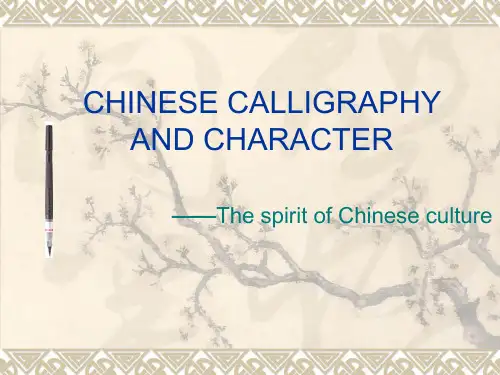
用英语介绍中国文化书法Chinese calligraphy, also known as "Shufa" in Chinese,is a traditional art form that has been practiced for thousands of years in China. It is considered one of the highest forms of Chinese visual art and is admired for its beauty, elegance, and cultural significance.The history of Chinese calligraphy can be traced back to ancient China, where it was used as a means of communication and expression. Over the centuries,calligraphy has evolved into a highly respected art form, with its own set of techniques, styles, and principles.One of the most distinctive features of Chinese calligraphy is the use of brush and ink to create characters. Calligraphers use a variety of brushes,typically made from animal hair, and black ink to write on paper or silk. The strokes of the brush are carefully controlled to create a harmonious balance of form, rhythm, and space.Chinese calligraphy is not just about writing characters, but also about expressing the calligrapher's emotions andpersonality. Each stroke is infused with the calligrapher's energy and spirit, making each piece of calligraphy aunique work of art.There are several major styles of Chinese calligraphy, each with its own unique characteristics and history. These styles include Seal Script, Clerical Script, Regular Script, Running Script, and Cursive Script. Each style has its own rules and conventions, and calligraphers often spend years mastering a particular style.In addition to its artistic value, Chinese calligraphy also holds significant cultural and philosophical meanings. It is often associated with concepts such as harmony, balance, and discipline, reflecting the core principles of traditional Chinese culture.Chinese calligraphy has also had a profound influence on other forms of art and culture, such as painting, poetry, and even martial arts. Many famous Chinese artists, scholars, and poets have also been skilled calligraphers, and their works have greatly enriched the cultural heritage of China.In modern times, Chinese calligraphy continues to thrive as a cherished art form, with many enthusiasts and practitioners around the world. It is often practiced as a form of meditation and mindfulness, offering a way to cultivate inner peace and self-expression.Overall, Chinese calligraphy is a rich and profound art form that embodies the essence of Chinese culture. It is a testament to the creativity, wisdom, and spiritual depth of the Chinese people, and it continues to inspire andinfluence artists and admirers around the world.中国书法,又称“书法”,是中国传统艺术形式之一,已有数千年的历史。